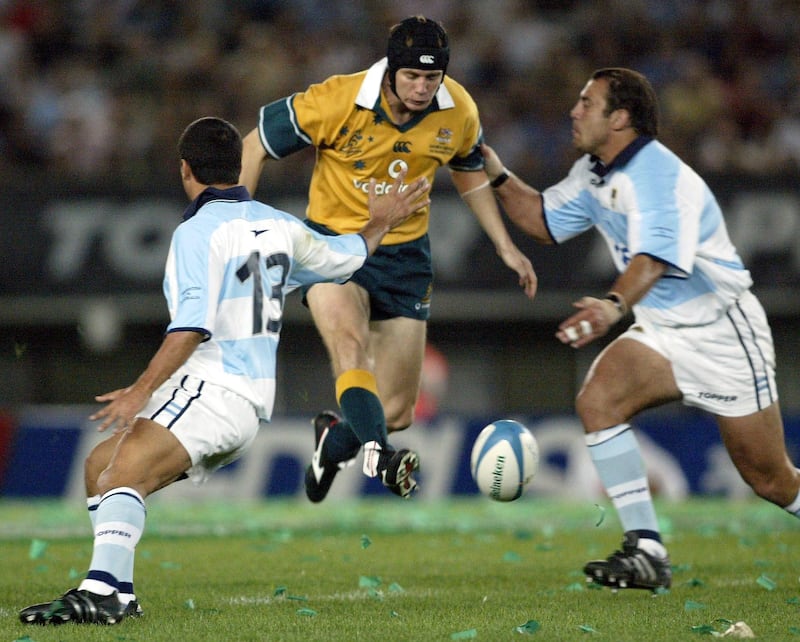For a small rugby nation like Ireland to produce two legendary outhalves such as Ronan O’Gara and Johnny Sexton, and have their careers run back-to-back, is an extraordinary situation.
For the best part of 20 years those two Irish greats have cast a long shadow over all other Irish outhalves. Attempting to grow in the darkness of a giant’s shadow is exceptionally hard.
That Ireland have had a great outhalf for such a long period has created a false sense of security among Irish supporters – that those who wear the green number 10 will always be a great.
Across the 1980s, 1990s and into the early 2000s Australian rugby lovers were in a similar situation. From Mark Ella, the greatest outhalf I have ever seen, to Michael Lynagh, followed by the excellence of Stephen Larkham, the Wallabies appeared to have mastered the alchemy of creating a production line of hall of fame 10s. That was until they didn’t. Like a tap, the flow of talent suddenly turned off.
At its heart, the simple reason for this was that across the lower levels of the game, young Australian outhalves stopped learning their craft.
[ Matt Williams: They say never meet your heroes - with JPR they were wrongOpens in new window ]
So it should never be taken for granted that the green jersey with number 10 on its back will always have a world class player wearing it.
Compared to countries such as New Zealand, France, England, and South Africa, Ireland have a very shallow pool of player talent available for selection in the provincial and national teams.

For Irish teams to be so exceptionally competitive, as they currently are, speaks volumes of the excellence of the academy system that is in place across the island. I have little doubt that the Irish system is the most efficient at producing high quality players in the world.
While admiring that proven system we need to add a drop of caution.
As the game has evolved over the past few decades, defensive systems have created line speeds that were not even dreamed of 20 years ago. As a direct consequence, when today’s outhalves receive the ball, they are being forced to make their decisions with far less time than ever before. That makes learning the craft of an outhalf exceptionally difficult.
[ Matt Williams: Be careful not to scare your kids off sport and lifeOpens in new window ]
Sports psychologists tell us that there is no such thing as instinct in sports. Instinct belongs with mother nature in the animal world. In sports, players learn how to make good decisions while under extreme pressure from experience. They achieve this by following the oldest and currently most unpopular law in education – repetition is the mother of all learning.
As the great Wallaby player and coach Dave Brockhoff would loudly broadcast at his sessions, when he was drilling his players towards excellence, “If you want to play in the symphony orchestra, you have to practise your scales.” It always produced the mental image of the lead violinist driving low and hard into the woodwind section, with the percussion players close behind in tight support. Brock understood we are what we repeatedly do.
Sports psychologists also tell us that players who make the best decisions while under extreme pressure are simply displaying their learned behaviour. Good decision making is learned by repeatedly making good decisions while under match like pressure.

Observations across Johnny Sexton’s extensive career, along with other sporting greats such as Tom Brady, the legendary seven-time Super Bowl winning NFL quarterback, support these theories. Both of these great players improved the execution of their accurate decision making, even as they aged before our eyes. They did not improve with age. They improved with experience.
As defensive systems targeted them, aiming to deny them both time and space, their long years of learning enabled them to seemingly slow down time and empowered them to make the correct decision in selecting the right option from the menu.
A combination of talent, passion for their craft and a dedication to grow, develop, and learn, all combined with the competitiveness of a Spartan warrior.
[ Matt Williams: Rugby is in a bad state but our leadership plays dumbOpens in new window ]
Needless to say, that type of person does not walk through the door every day.
Jack Crowley is a very promising young player. He has displayed great skills, self belief, and confidence. I am expecting him to step out of Sexton’s shadow and in two weeks walk out under the lights and into the caldron that is the Velodrome in Marseille.
The Velodrome is a rectangular stadium designed for football with the spectators almost on top of the players. In my experience, it is an environment far more hostile than the Stade de France in Paris.

Crowley is made for this type of challenging and exciting environment, but at the same time the Irish rugby public must give the young man some understanding that when a player follows a great, like Sexton, the first few games may not be at Sexton’s gold standard.
I am not trying to degrade or devalue the play of Crowley. I am trying to do the exact opposite.
I am attempting to defend Jack from unreasonable expectations. Like all young players Crowley needs time in the white hot heat of elite test match rugby to learn and develop his craft.
In his first few moments on the big stage at the recent World Cup, Crowley as we say, forced the game. That is, he tried far too hard. A rushed attempt at a drop goal against South Africa and an uncalled for and poorly executed chip kick against Scotland were symptoms of immaturity.
While we never want to coach the creativity out of a talented player like Crowley, he also has to be educated as to when to metaphorically pull the trigger.
That takes experience only gained through match time.
At a relatively young age and with limited time at both provincial and International levels we all need to give Jack Crowley some time and space to learn, grow and develop.


















